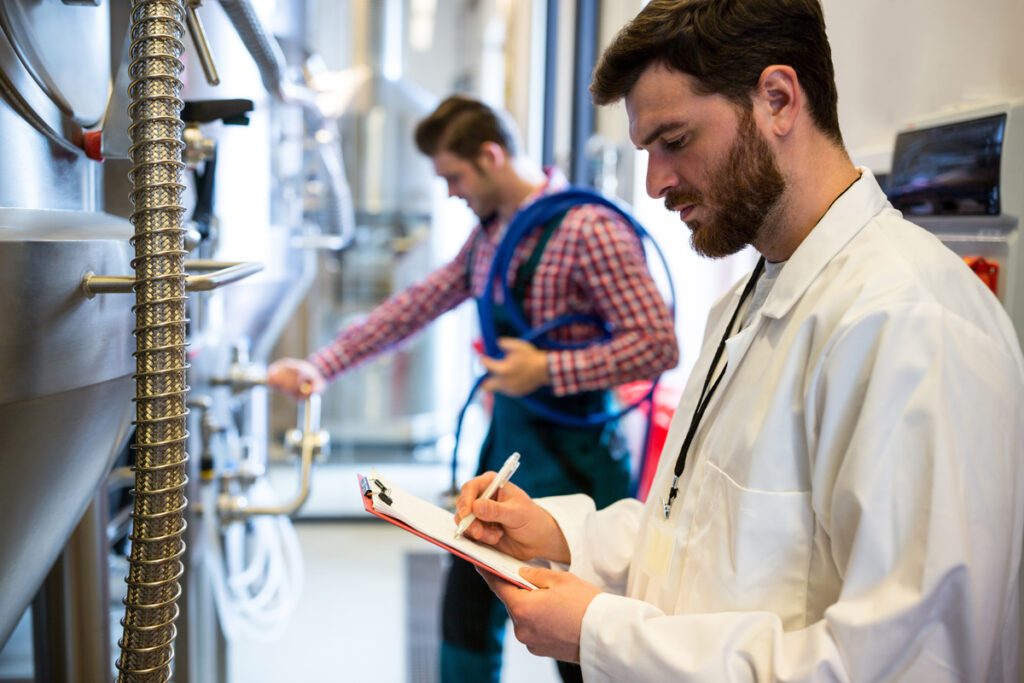In recent years, food safety standards in the US and Canada have become more stringent and now cover all food offered for sale in these countries. If you’re new to the industry, you must first navigate intricate import, manufacturing, and labeling regulations for food. Prior to manufacturing your new product or beverage, food inspectors will ask you to get a food permit and develop a food safety plan.
What is a food safety plan?
Simply put, a food safety plan is a written document that identifies the critical food handing and processing operations leading to the manufacturing and sale of safe food.
We use a risk management approach to identify which food safety hazards are likely to endanger health of consumers. Recent recalls such as the Nestlé/Buitoni frozen pizza recall (France) and the Ferrero Kinder Surprise recall (UK) point to the importance of food safety plans and the need for proper implementation. Significant hazards in the HACCP plan are controlled by applying good handling and manufacturing practices supported by scientific principles. Food safety plans are the cornerstone of a company’s food safety culture program and necessitate frequent training and active leadership.
What are the standards?
The internationally accepted standard for food safety plans is Hazard Analysis and Critical Control Points (HACCP). HACCP is a 12 step-food safety methodology first introduced in 1969 by the FAO/WHO. Codex HACCP, as we call it, is the basis for some well-established standards such as Seafood HACCP (FDA 21 CFR 123), Juice HACCP (FDA 21 CFR 120) and the Food Safety Enhancement Program (FSEP) in Canada. Recent framework for food safety management was introduced by the US FDA in 2011, called the Food Safety Modernization Act which mandates certain food businesses implement Preventive Control plans for Human Food. A Preventive Control Plan for Human Food is more encompassing than a HACCP plan and applies to FDA-regulated food products that are not already subject to a HACCP-based FDA regulations. Note: modified requirements apply to some food products such as Low-acid canned foods. It is crucial to understand the type of products you manufacture to determine which food safety regulations apply and what food safety plan is required.
Where to start
If you are searching for guidance implementing HACCP, we first recommend that you attend an accredited HACCP training course. Codex HACCP and the FSEP program (Canada) provides guidance as well as record templates for implementation of HACCP plans. In addition, the Safe Quality Food (SQF) code – a popular food safety certification in North America – provides a detailed requirement and guidance implementating a HACCP plan.
Steps of Codex HACCP
We specialize in certifying businesses to SQF and teaching the SQF code, let’s review and interpret the requirements for 2.4.3 Food Safety Plan under SQF 9 – Food Manufacturing. The SQF requirements are compliant with the 12 steps of the Codex HACCP standard.
2.4.3.1 – A Codex HACCP plan is documented for all foods under the scope of certification. More than one HACCP plan may be implemented depending on your manufacturing or food transformation processes.
2.4.3.2 – The food safety plan or plans must be created and maintained by a cross-functional team led by a HACCP coordinator who hold a valid HACCP training certificate. The HACCP team receives adequate training.
2.4.3.3 – The plan covers the start and endpoints of the handling/manufacturing/transformation processes as described in a process flow diagram.
2.4.3.4 – Product descriptions (understand food safety specifications such as the need for cold storage, the presence of allergens in the food, the food pH and water activity, its modified atmosphere, whether it is ready-to-eat, ready-to-cook or re-heat) are developed and documented for all products within the scope of the HACCP plan(s).
2.4.3.5 – The intended use of each product and target/vulnerable consumer groups are identified.
2.4.3.6 – A flow diagram is developed and verified by the HACCP team. It includes “raw materials, packaging, service inputs (e.g., water, steam, gasses as applicable), scheduled process delays, and all process outputs including waste and rework.”
2.4.3.7 – The food safety team identifies food safety hazards at each step in the process considering all plan inputs and outputs. The flow diagram is used as a guide for the completion of this step. Hazard guides may be used to facilitate this step. We recommend the FDA hazard guide and the CFIA RDHI.
2.4.3.8 – The food safety team determines significant hazards in the process using an agreed upon methodology is used consistently throughout the analysis. A quadratic risk matrix is used for this HACCP step. Refer to SQF Tip sheet #6 Overview of HACCP.
2.4.3.9 – The food safety team establishes control measures to control all hazards.
2.4.3.10 – Based on the results of the hazard analysis the food safety team identifies critical control points (CCP’s) for all significant hazards. Process steps may be changed or altered to address hazards.
2.4.3.11 – For each identified CCP, the team determines and validates critical limits. Download a copy of the FSPCA manual – See Chapter 13 and Validation Study example on page A3-14.
2.4.3.12 – CCP procedures are then developed and approved to monitor Critical Limits at each CCP to ensure safety levels are achieved. CCP operators are trained to conduct monitoring and corrective actions in the event of process failures. They also receive training on making process adjustments and placing potentially unsafe food on hold.
2.4.3.13 – The food safety team develops and implements deviation procedures to anticipate CCP failures. These standard operating procedures include the disposition of affected product and corrective actions to prevent recurrence of the CCP failure.
2.4.3.14 – The team documents, approves and implements the food safety plan(s). A full review of the plan is performed annually or when in the event of process, equipment, inputs, or other changes affecting product safety.
2.4.3.15 – Validation procedures are implemented to verify that critical control point procedures are effectively monitored and that appropriate corrective actions are applied.
2.4.3.16 – Records of CCP monitoring, corrective action, verification activities are maintained according to regulatory expectations (2 years under SFCR and FSMA regulations, 2 years under SQF).
You may access additional guidelines by downloading SQF TIP sheet #6 – Overview of HACCP.
Summary
1 – Attend a HACCP training class and obtain your HACCP training certificate.
2 – Download HACCP guidelines and HACCP form templates (Risk matrix info – SQF tip sheet#6, FSEP and Codex HACCP form templates). Implement the 12 steps of HACCP.
3 – Use FDA and CFIA hazard guides to complete your food safety risk assessment.
4 – Provide HACCP training to CCP operators and HACCP team members.
5 – Validate your critical limits (See FSPCA manual), review your HACCP plan at least yearly.
Need to develop or update a HACCP plan to meet regulatory or industry certification requirements? Contact Sirocco to discuss your food safety plan needs and food safety implementation with our SQF and HACCP consultants.





